The pine trees are slumping lazily under the weight of a foot of snow on their branches. The wind is howling, every gust carrying snow from the treetops to the ground in a series of flurries. I start the engine, and a cloud of water vapor engulfs the truck. The thermometer reads -10°F. Such is the morning after a New England blizzard.
The next thing I know, I’m zooming through the mountain roads of Maine. The sun is shining, the snow is soft, and I wouldn’t miss a powder day for my life. I pass someone, round the bend, and am greeted by shade—and the largest patch of black ice I’ve ever laid a tire on. I control the skid for a whole five seconds before violently slamming into a guardrail.
I study the damage. A fog light is gone, and the bumper is hanging on for dear life—no big deal. But the left outer tie rod end is completely broken, sheared off at the ball joint. It’s the second time I’ve damaged that particular tie rod end, the first time just a few weeks earlier on a 4×4 route in Southern Utah. Just my luck.
I limp the vehicle a few miles to the nearest parking lot, keeping it in four-wheel drive and forcing the front left wheel to track straight. I jack the vehicle up and remove the wheel. With the help of a pipe and impact wrench, I remove what’s left of the outer tie-rod ball joint. Then I drill a hole through what’s left of the tie-rod end, reconnecting it back to the steering knuckle with some paracord and a trusty ski strap. I drive 30 miles back through the mountains to the nearest auto parts store, where I replace the part for real. My record of never being left stranded by a vehicle still stands.
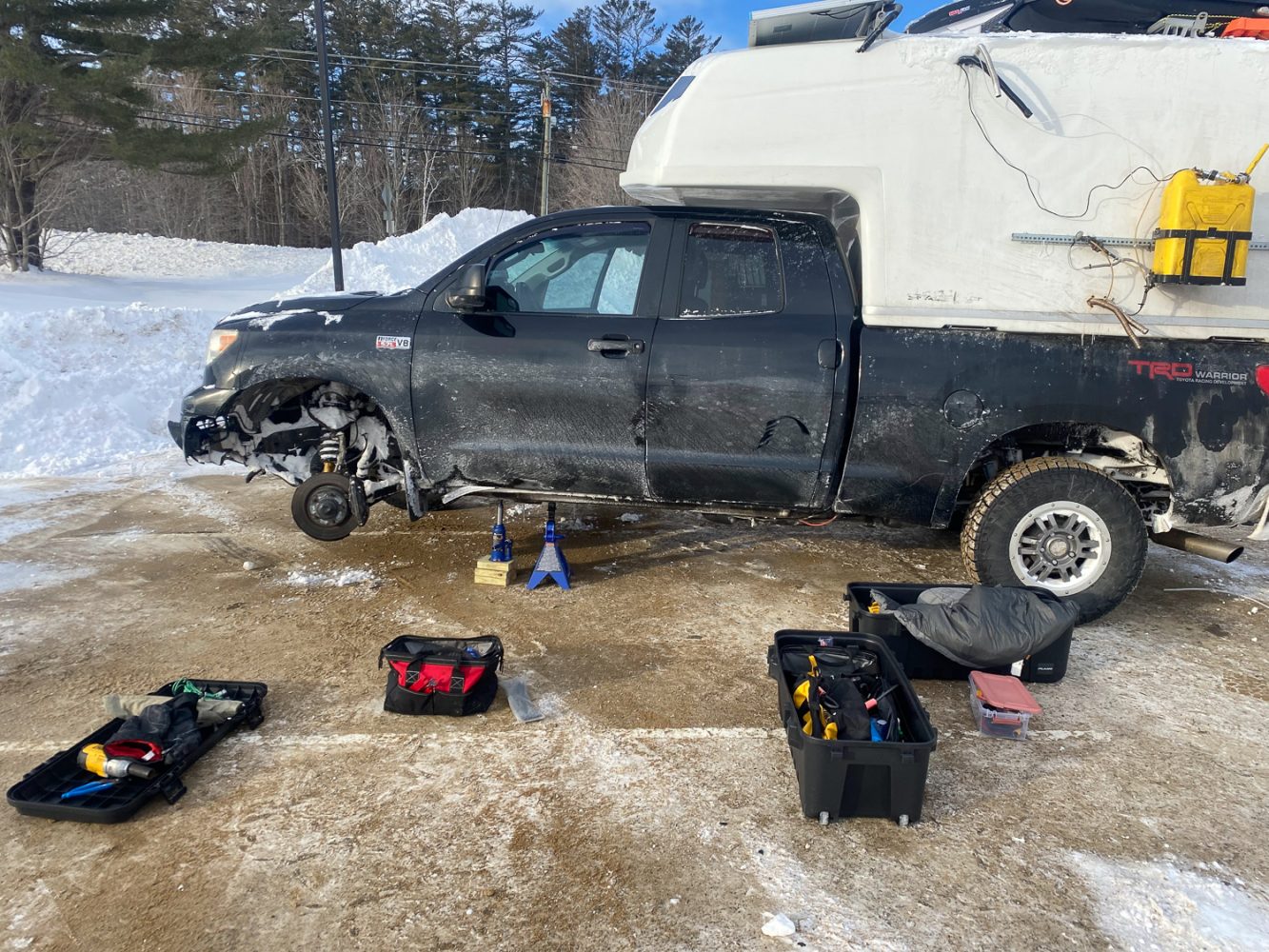

I’m not particularly nice to my vehicles. After driving my first vehicle, a 2012 Toyota RAV4, through terrain a compact crossover should never be in, it looked like it came out of a war zone. The bumper was held up by zip ties, the rear hatch closed with paracord, and there were more scratches and dents than paint left on it by this point. From squeezing through canyons in Utah to barreling through 4WD routes during the winter in the Colorado Rockies, it had been through a lot. Despite the sheer abuse I put that poor vehicle through, it never left me stranded. It was a little tight for long-term living, though, especially with the mountain of outdoor gear I had acquired. I began looking at other options, and I knew that I needed unmatched reliability and off-road prowess.
A pickup truck platform made the most sense for me—they’re reliable, easy to work on, and capable off-road. Furthermore, I would have plenty of interior space while still being small and mobile enough to park at trailheads and navigate city streets. Ideally, I wanted a custom-made expedition camper molded to the cab or as part of a flatbed, but being a young college student, that was well out of my budget. I began to peruse commercial truck bed camper options, but those wouldn’t work for my usage. Most of them had plumbing systems which would quickly be destroyed by subzero temperatures. Furthermore, they all had limited storage space. Where would I store two bicycles, two snowboards, seven pairs of boots, and an armada of backpacking, mountaineering, bikepacking, ice climbing, rock climbing, and backcountry gear?
It seemed like something with a self-built interior would make the most sense for my needs and budget. There were very few empty shell options in the US market, but living in Boston, I stumbled upon an offering from a small company in nearby Quebec called SpaceKap. They offer the Diablo, a fiberglass cab-over shell tall enough to stand in. It was marketed as a “van body for a pickup truck” and is primarily used by tradesmen in Canada as a more capable and robust alternative to a van. It comes in at an incredibly light 725 pounds for a 6.5-foot bed model. Surprisingly, I could find very few instances of these being converted into campers. This was uncharted territory. Even so, the price was right at $11,000, and the camper would be produced, shipped, and installed, with a roof rack added. I pulled the trigger.

The low weight meant that I could use a half-ton pickup truck and remain within payload. The vehicle choice was a no-brainer; already familiar with the legendary Toyota reliability, I began searching for a Toyota Tundra. After a week of aggressive searching, I found something promising: a 2010 Tundra TRD Rock Warrior (precursor to the TRD Pro) with a gas-guzzling 5.7-liter V8. It had high mileage at 200,000 miles, but the owner had recently replaced the struts, shocks, alternator, water pump, radiator, starter, battery, pads, and rotors. I negotiated the price down to $12,500 and bought it the same day.
2010 Toyota Tundra 4WD TRD Rock Warrior Edition
The first upgrade was a set of five 285/70R17 Falken Wildpeak AT3W tires, along with a matching fifth rim to enable five-tire rotation. While they offer amazing performance off-road, it’s on the snow where they truly shine, performing similarly to snow tires. Spending my winters in the Rockies and New England, snow performance was an absolute necessity. I also installed a VelociRax five-bike rack mounted to a RakAttach hitch swing arm, so that I could have easy access to the camper.
Unfortunately, I soon discovered a few critical repairs needed. The front wheel bearings were going bad; replacing them became a two-day affair. They were the original parts, and 11 years of New England rust was tough to break through. Even worse, after removing the original plastic bedliner, I discovered several gaping rust holes that threatened the bed’s integrity. I ground out the worst of the rust and painted over the rest with POR-15 rust sealer before patching the holes with either sheet metal or Bondo body filler and then finally going over the entire bed with a paint-on bed liner. After several days of hard labor, it was good as new.
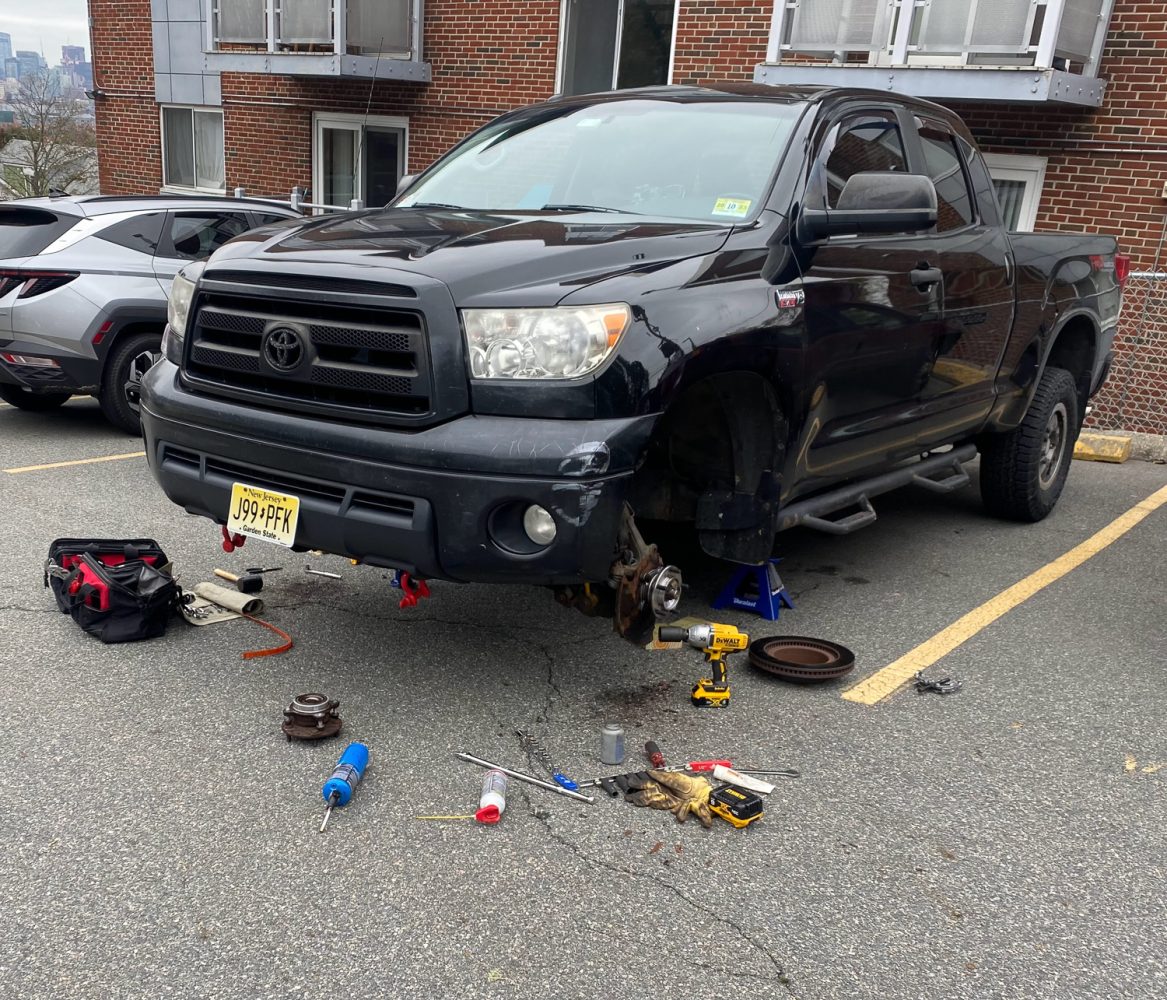
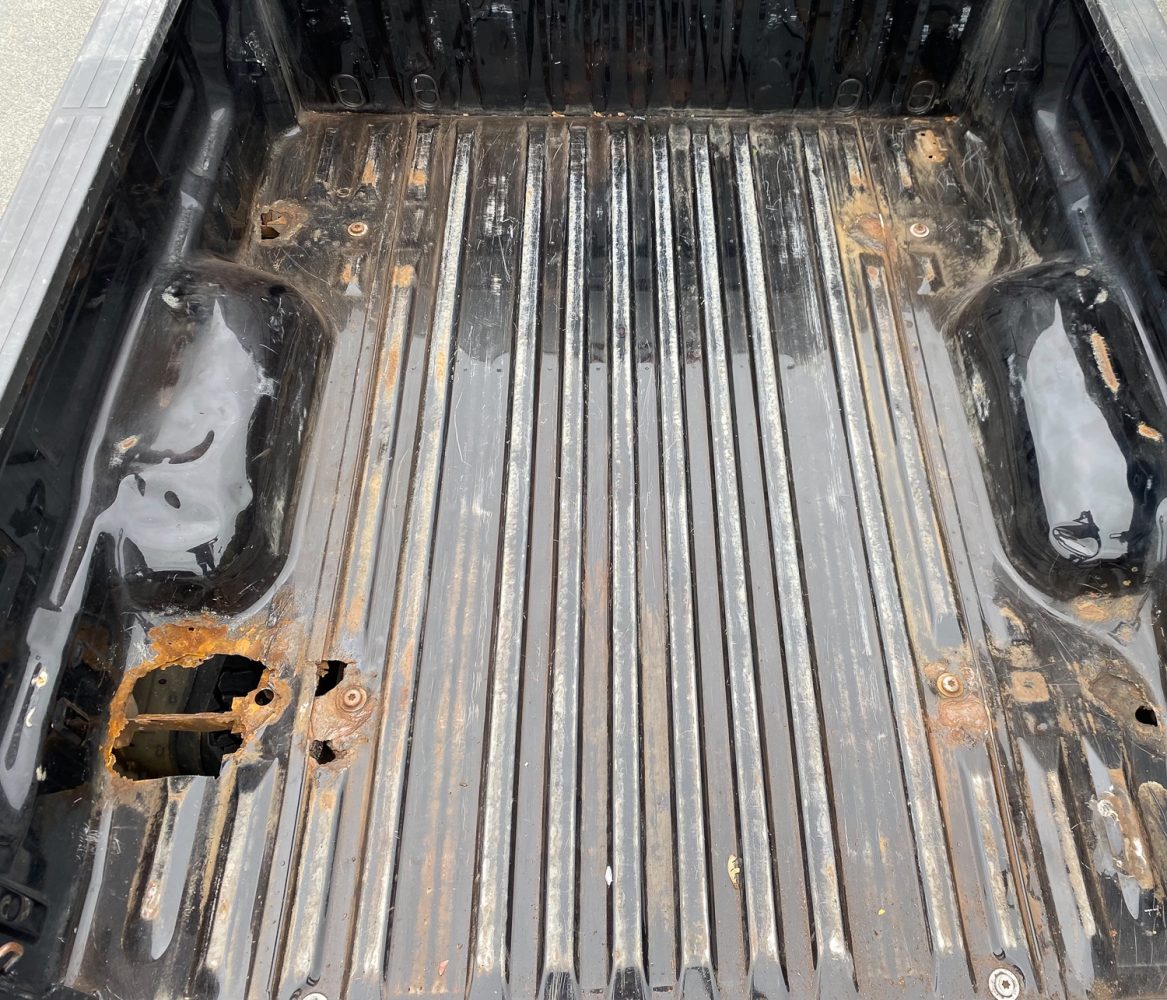
SpaceKap Diablo Fiberglass Cab-over Shell Conversion
A mere four weeks after ordering, the camper arrived and thus began my work. Living in an apartment complex with a tight parking lot, I didn’t have space to build—I had already got chewed out for replacing my wheel bearings there. The majority of the build was completed in the Boston Home Depot lot, much to the amusement of the employees. You can’t beat the convenience of a 30-second walk to the hardware store and the space to spread out and operate loud power tools at all hours of the day or night.
I approached the build like a campervan conversion, primarily using 3/4-inch plywood and two-by-fours as the building materials of choice, and began by installing the floor (3/4-inch plywood with a vinyl sheet on top). Then, I built a shelf system/countertop on the left side of the camper to house the electrical system, stove, sink, cooking supplies, and fridge/freezer. This was significantly more difficult than I expected—there are no straight lines on the walls, and it is slightly tapered throughout. I must have purchased three times as much wood as I used until I got the measurements right.
For the electrical system, I used a Renogy 200-amp-hour LiFePO4 battery with a 1,000-watt inverter powered by a 200-watt solar panel and a hybrid solar charge controller/battery isolator. The solar charge controller/battery isolator allows me to charge both off the sun and the vehicle’s alternator, negating the need to find adequate sunlight, which can be a problem in the winter.
On the right side of the camper, I built an elevated sofa bed that runs the length of the interior. The structure is mounted on heavy-duty drawer slides, and the back of the sofa is built on a piano hinge. When extended, it flattens into a 48-inch-wide bed. I also made judicious use of elevated storage, keeping all my food, water bottles, and mugs on a shelf with other supplies placed in baskets screwed to the walls. These design decisions had the advantage of yielding a huge amount of storage space. In truck campers, the cab-over portion is almost always the sleeping area, and there is a separate sitting area in the truck-bed portion of the camper. By combining the seating and sleeping area, I had the entire cab-over space to use as a gear loft for storage. The space underneath the sofa bed was the perfect location to store boots, snowboards, and other gear. Then, to quite literally “top it all off,” I installed a Yakima Skybox 16 on the roof (accessed by a ladder) for even more storage space.
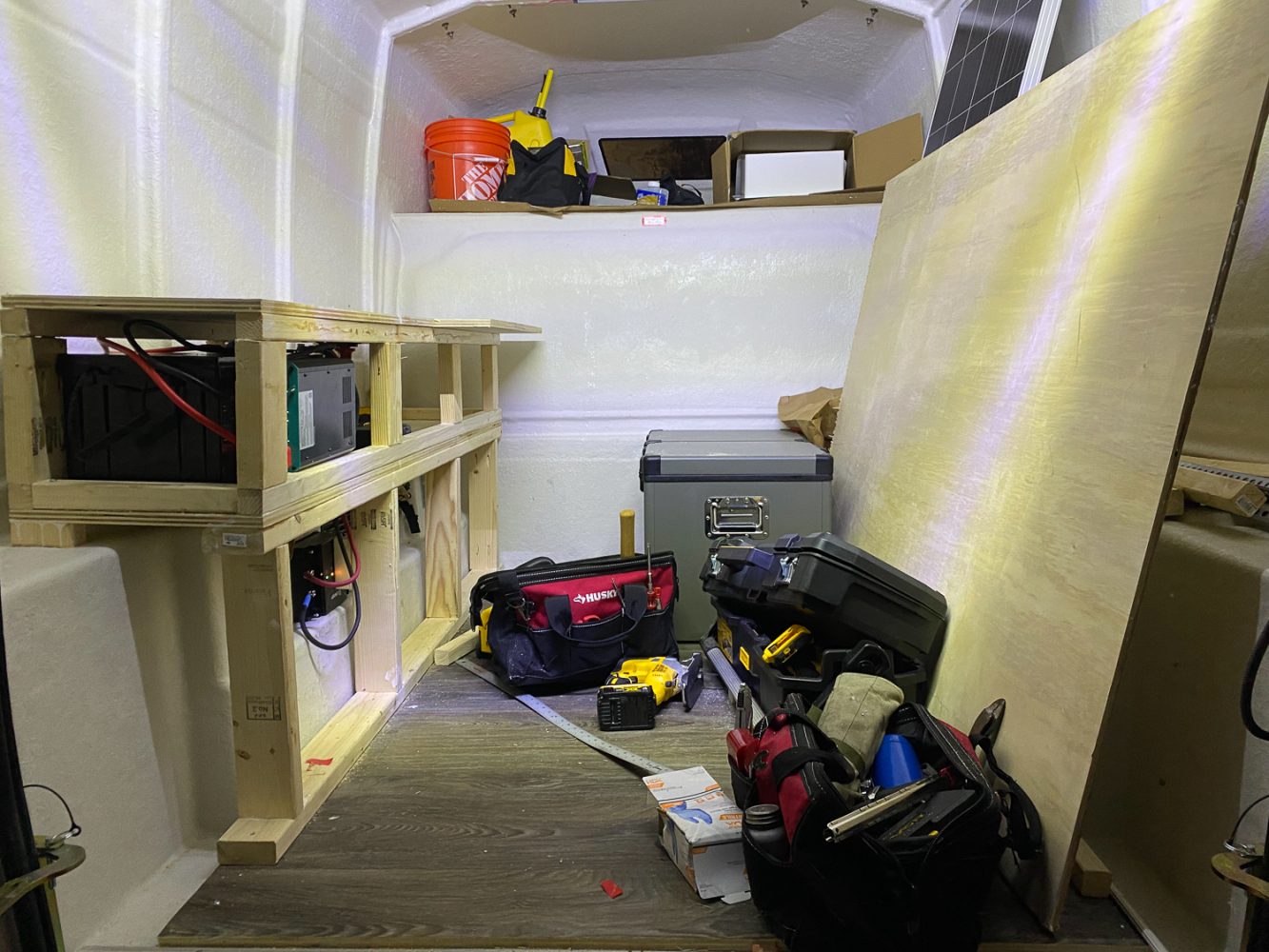


Appliances include an Iceco VL60 fridge/freezer, which is energy-efficient and allows me the priceless luxury of instant access to ice cream (my favorite food) wherever I may be. For ventilation, I installed a MaxxAir 7500k MaxxFan Deluxe roof vent. And finally, the most important appliance, a heater. Whether it be a ski resort parking lot or a 4×4 mountain pass in the winter, I needed to stay warm. I started with one heater, a simple 2-kilowatt Chinese diesel heater mounted to the wall connected to an externally mounted diesel tank. After spending two nights in Leadville, Colorado, at 10,000 feet above sea level, the heater quickly failed. I replaced it with a used Webasto and, anticipating additional heater failures, bought another 2-kilowatt Chinese diesel heater and an old-school kerosene lantern. With just one diesel heater, I can keep the uninsulated interior at 70°F while it’s 25°F outside, and with all three, I am set for any temperature.
As for cooking and plumbing, I wanted something minimalist and modular. Any plumbing would become destroyed by extended periods of freezing temperatures, so I selected a gravity-fed water system by way of a 5-gallon Scepter water can and a 4-gallon reliance Aqua-Tainer. The sink is a collapsible camping one, which I put on top of a 1-gallon water jug I use as my “graywater tank.” The Coleman Triton stove has two burners and uses 1-pound propane tanks. It’s a crude system for sure, but simple, easily replaceable, and has virtually nothing that could fail.
When the build was finally completed, the time came to embark on its maiden voyage—a month-long trip out West during my winter break. This was my fourth time driving across the country east to west, but the endless farms of the Midwest never get any less boring. Seeing the Rocky Mountains dominate the horizon as you approach Denver makes it all worth it.
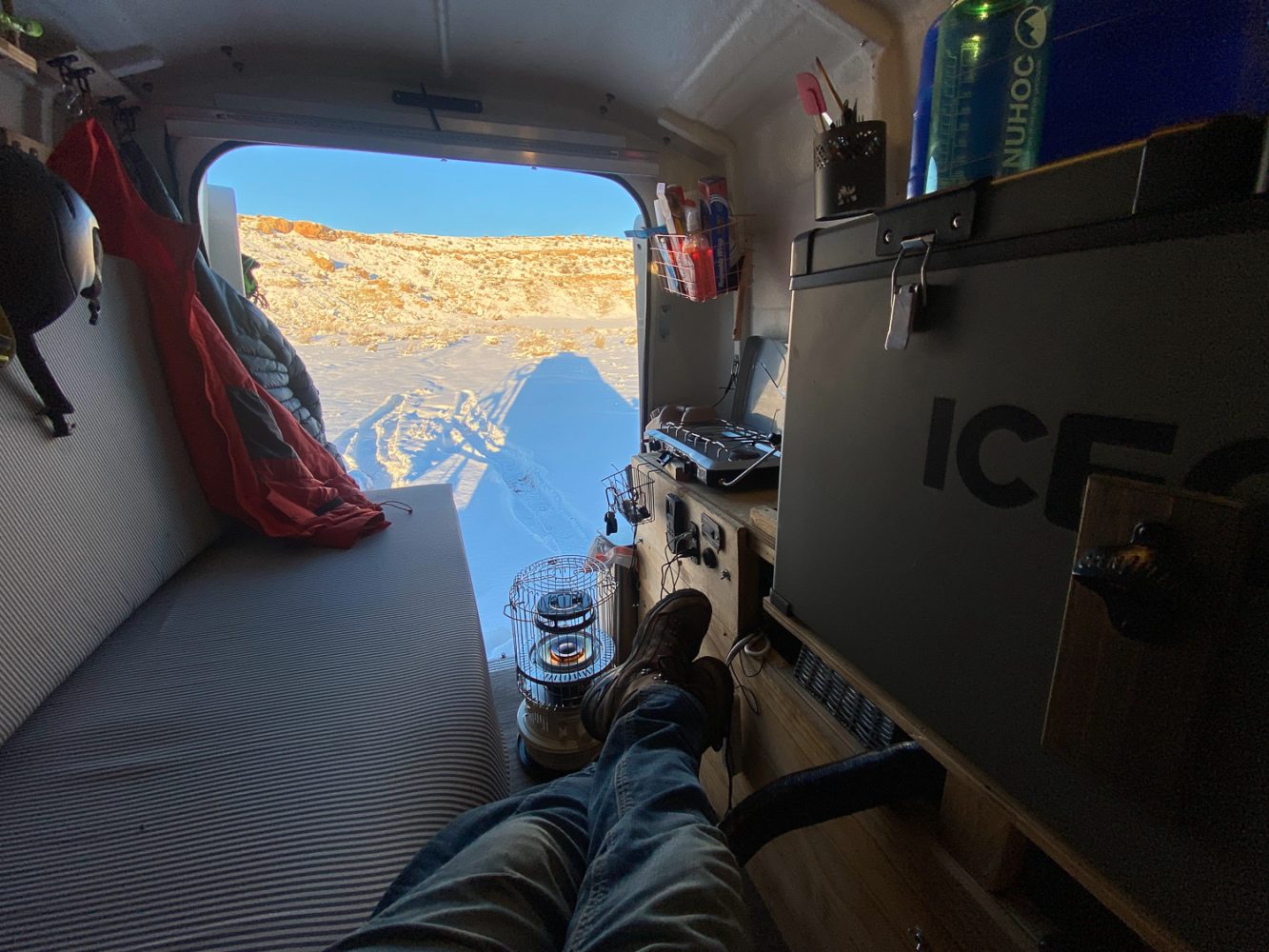
The frigid parking lot of Copper Mountain, Colorado, situated at 9,700 feet above sea level, was no match for the camper. It was surreal to walk from the lift to your home on wheels after a long day of riding, crank up the heat, and have your powder-laden clothes dry in just an hour. However, the 4×4 roads surrounding the mountain hamlet of Leadville were a formidable foe. After a few major snowstorms, I aired down, chained up, and headed into the mountains. Two feet of powder proved to be fine, but when 2 feet turned into 3 feet, the vehicle became stuck for the first (and only) time. Careful not to spin the tires too much, a few feet of laddering my traction boards and the presence of a skilled spotter got me out of that situation. I did end up one traction board poorer (lost to the snowpack), but come spring, some lucky person will be one traction board richer.
After the relentless cold of the High Rockies, southern Utah was a treat. The mounds of snow that had taken permanent abode in my wheel wells got their chance to melt off, and I could step outside without wearing a pair of boots for the first time in weeks. It presented a different type of challenge, however. A few days driving way too fast through Cathedral Valley’s rough and rocky 4×4 routes pushed the rusty truck to its limits. Upon my return to pavement, the handling was poor, and I discovered that the left outer tie rod end joint had a significant amount of play in it. It would have been a terrible idea to return off-pavement, and the nearest auto parts store with a tie-rod end for a Toyota Tundra ironically was back in Colorado in Grand Junction. One hairy drive later, I made my first emergency repair in an AutoZone parking lot.
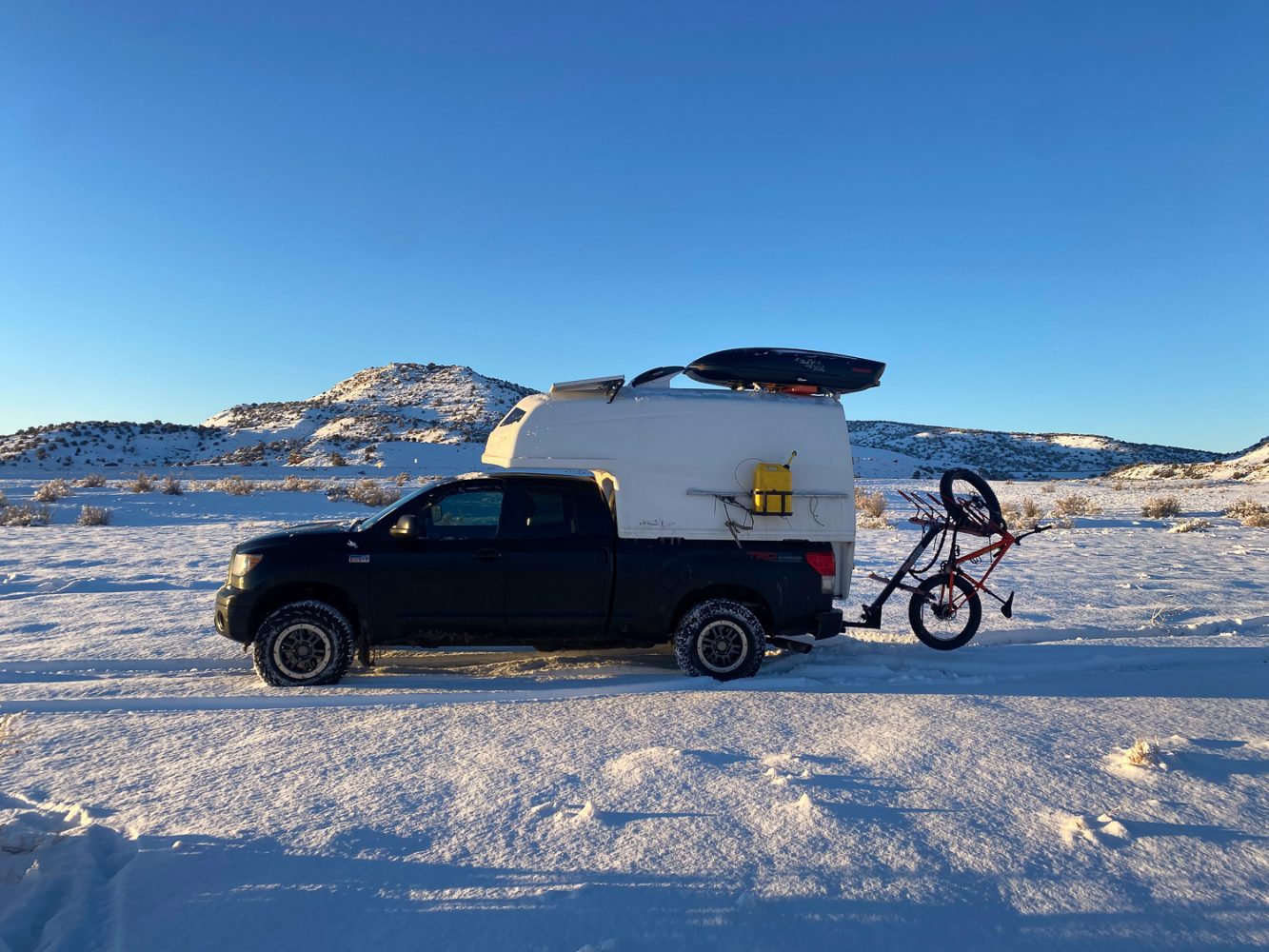
The first sentence of Murphy’s law famously states, “Anything that can go wrong will go wrong.” What resonates most with me is the last sentence, though, which reads, “If everything seems to be going well, you have obviously overlooked something.” In every one of my adventures, something has gone wrong. If just a day goes by where everything seems perfect, I know something has gone wrong and hasn’t yet been discovered. Therefore, I believe that the most important part of any build or adventure is the tools and knowledge to keep everything running smoothly. I’ve quickly learned to keep a large assortment of tools in my vehicle, and I have used all of them. You never know what will break, fail, or end up needing repair. The self-sufficiency to fix most of what could go wrong with your equipment on any adventure is invaluable, and it pays off several times over to be prepared.
Specifications:
- 2010 Toyota Tundra 4WD TRD Rock Warrior Edition, double-cab, 6.5-foot bed
- 5.7L V8 3UR-FE engine
- Six-speed automatic AB60F transmission
- Three-inch front and 2-inch rear leveling kit
- SumoSprings SSR-610-54 Helper spring
- TRD Rock Warrior 17-inch Alloy rims with 285/70R17 Falken Wildpeak AT3W tires
- RakAttach hitch swing-arm mount
- VelociRax 5X hitch-mount bike rack
Recovery and Off-Road Gear:
- Smittybilt 2781 5.65 CFM air compressor
- ARB E-Z deflator
- ARB SpeedySeal tire repair kit
- Strongway 4-ton heavy-duty cable puller (hand winch)
- Maxsa Escaper Buddy traction board with metal grips
- Smittybilt CC220 recovery strap
- Logging chain, 20 feet, 3/8-inch
- SmittyBilt 3/4-inch shackles
SpaceKap Diablo Camper:
- SpaceKap Diablo fiberglass cab-over shell
- Iceco VL60 fridge/freezer
- MaxxAir 7500k MaxxFan deluxe roof vent
- Webasto Air Top ST 2000 diesel heater
- Chinese diesel heater, 2 kilowatts
- Dyna Glo 10,500 BTU kerosene convection heater
- Renogy 12-volt 200Ah LiFePO4 battery with Bluetooth
- Renogy 1,000-watt 12-volt pure sine wave inverter
- Renogy DCC50S 12-volt 50A DC-DC onboard battery charger with MPPT
- Renogy 200-watt 12-volt monocrystalline solar panel
- Scepter 20-liter diesel fuel can
- SmittyBilt gas can holder
- The Foam Factory custom 24- by 75-inch mattresses
- Reliance 4-gallon Aqua-Tainer
- Scepter 20-liter water jerry can
- Coleman Triton two-burner propane stove
- SOL 8-liter Flat Pack collapsible sink
- Yakima SkyBox 16 Carbonite
Our No Compromise Clause: We carefully screen all contributors to ensure they are independent and impartial. We never have and never will accept advertorial, and we do not allow advertising to influence our product or destination reviews.


